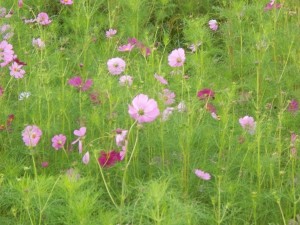Here’s a pretty piece of prosery from one of my Actual-Japanese Japanese Books, 鈴の鳴る道, by 星野富弘. It appears under a picture of cosmos, one of my favorite flowers. I love the way they looks like a watercolor when growing altogether in a field.
風は見えない
だけど木に吹けば
緑の風になり
花に吹けば
花の風になり
今、私を
過ぎていった
風は
どんな風に
なったのだろう
I freaked a little when I rediscovered this a few months ago, because I knew almost every 漢字. This happens a little more each time I “study,” but it still feels like a big deal. The only two characters I didn’t know, and had to look up, were 緑 and 過ぎ, and they weren’t necessary to get the basic gist. I like to translate this poem so:
We cannot see the wind itself
Even so, it blows through the trees
Becoming a green gale
It blows through the flowers
Becoming a wave of flowers
Now it is myself
Which the wind has passed through
What kind of wind
has it become?
Obviously, this is a pretty self-reflecting translation. But it’s how I read it, all by myself, ignoring the words “passed” and “green” out of illiteracy. The word wind – I just couldn’t bring myself to repeat it so many times. I stuck in some rather fanciful additions instead. Yes, they add variety, but more then that I think “green gail” more clearly expresses the idea of all the leaves in motion than “green breeze.” After all, what we have is no longer a quiet, respectable tree, but a manifestation of the wild wind. I got to see this poem in action this morning. It snowed last night and then gusted all day long, sending swirls of sparkling pixie dust whirling through the sky. 雪に吹けば/雪の風になり. The world lends itself as a body to the invisible wind, and in return that wind teaches it to dance, showing how detailed and complex its world is. When the wind tugs at my skirt, or blows icily against my face, what kind of wind is it making of me?
There, that’s my defense of my artistic license. How would you translate this differently? Do you think I’ve missed the meaning?

